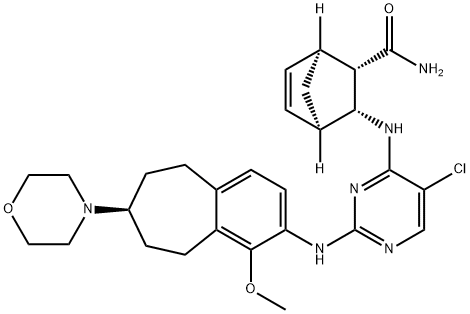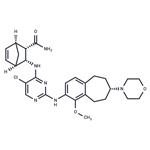CEP-28122 is used as an orally efficacious inhibitor of (ALK), analplastic lymphoma kinase, in the treatment of cancer.
cep-28122, a highly potent, selective, orally bioavailable inhibitor of alk, dampens the phosphorylation of alk and alk substrates in cells and triggers cytotoxicity or growth inhibition of alk-positive cancer cells with a favorable pharmaceutical and pharmacokinetic profile and selective pharmacologic efficacy. cep-28122 blocks alk tyrosine phosphorylation in tumor xenografts in mice. alk, which is constitutively activated in many human cancer types because of point mutations, gene amplification, and chromosomal translocations, has emerged as an excellent molecular target for cancer therapy.
cep-28122, concentration-dependently, triggered growth inhibition/cytotoxicity of alk-positive anaplastic large-cell lymphoma (alcl) via inhibiting nucleophosmin (npm) -alk tyrosine (664) phosphorylation. due to the cep-28122 treatment, eml4-alk tyrosine phosphorylation was blocked in non-small cell lung cancer (nsclc) nci-h2228 and nci-h3122 cells and full-length alk receptor tyrosine phosphorylation was inhibited in neuroblastoma cell line nb-1 cells [1].
severe combined immunodeficient (scid) mice bearing sup-m2 (b) or nu/nu mice bearing colon carcinoma hct-116 (c) subcutaneous tumor xenografts were administered orally with cep-28122 at 3, 10, or 30 mg/kg for 24 days. cep-28122 showed inhibition of alk tyrosine phosphorylation in a dose-dependent manner in tumor xenografts in mice when treated at 30 mg/kg. moreover, cep-28122 displayed dose-dependent antitumor activity in alk-positive alcl, nsclc, and neuroblastoma tumor xenografts in mice when administered orally at 30 mg/kg or higher [1].
1.9 nm: blocks anaplastic lymphoma kinase (alk).
[1]. cheng, m., quail, m., gingrich, d., ott, g., lu, l., & wan, w. et al. cep-28122, a highly potent and selective orally active inhibitor of anaplastic lymphoma kinase with antitumor activity in experimental models of human cancers. molecular cancer therapeutics. 2011; 11(3): 670-679.


